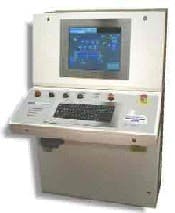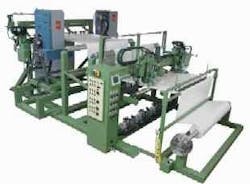The reasons the machine builder finds to justify the move to new controls will vary just as the timing does. This article examines the way five industrial machine builders decided they could and should justify the investment and the risk.
While those reasons might vary, the end result is the same,their customers realized substantial benefits, and the machine builders strengthened their market positions.
Manual Control Kills Consistency
Extru-Tech (www.extru-techinc.com) in Sabetha, Kan., is a manufacturer of extrusion systems sold internationally to the pet food, aquaculture, animal feed and human food industries. Its decision tree for upgrading controls was driven by the need to meet increased expectations from its customers, first and foremost.
The conversion of grain-based formulas to food and feed requires the metering of the mash (grain blend) to the extrusion system at precise rates and the addition of steam, water, oils, colorants, chemicals, slurries and often fresh meat at specific rates. The extrusion system combines ingredients in a conditioning cylinder, mixes, hydrates, elevates temperatures and then exposes the conditioned mash to the extruder barrel. As the product exits the barrel through a die plate, the cooked formula is shaped and cut to size by a rotary knife with a variable-speed drive.
"Wide fluctuations in final moisture will have a direct impact on product quality, stability and bottom-line profits," says William Huseby, director of sales at Extru-Tech.
Extru-Tech provided manual controls with its equipment and attained acceptable results for many years. "However, in today's environment, the cost of labor, utilities and raw materials continues to climb and the use of control automation is becoming a requirement for bottom-line conscious operations," says Huseby.
Huseby's group realized that consistency of production and product quality is of utmost customer importance and moving to next-level automation would help assure this,even with changeover in operating personnel. "We saw we had to have consistent control of material feed, steam, water and other additions to the system, and make certain that gelatinization in the pre-conditioner remains constant and final product quality can be reasonably determined without excessive sampling, says Huseby. "We also saw we could eliminate some blending operations and provide the ability to combine ingredients, both dry and liquid on-line. This also indicated significant reduction in changeover time. Changeover time reduction relates to the ability to blend on-line and the possibility to run one formula to the end followed immediately by the next formula. Combine the increase in production with reduced changeover time and lack of rework and you have measurable results."
Bachelor Controls (www.bachelorcontrols.com) worked with Extru-Tech to develop the Autopilot extrusion control system and realizes the dilemmas that are there for companies considering new automation. "We often struggle with 'what the customer needs vs. what we're capable of providing' issue, so we only try to push for performance enhancements when we can justify them as the best solution for the customer," says Will Henry, senior project engineer, Bachelor Controls. "Our best performance enhancement example actually led to the development of a packaged solution, which further drove down production costs and increased ROI."
Companies now using Extru-Tech equipment with the Autopilot control system report a 10% increase in yields (See Figure 1). Huseby says customers have reported that the control enhancements have allowed them to increase production rates more than 40%, much of it from changeover time reductions of up to 66%.
40%, much of it from changeover time reductions of up to 66%.
Box-In the Business Issues
A good control system integrator can help a manufacturer understand the business issues that support a control system upgrade justification. "When Concept Systems looks at an opportunity, we try to show a return on investment in six months," says company president Ed Diehl. "This ROI period may differ depending on the industry and the particulars of the system, but key factors that enter into the equation for us include the amount of increased machine availability due to reduced setup time for production changeover and decreased downtime for routine maintenance."
Diehl says the reduced amount of scrap or waste product resulting from improved quality control, as well as lower energy consumption (a huge issue for certain customers because a new control system often can be justified by the energy savings alone)and increased production rates (from tighter controls that often allow machines to run faster and produce cost savings due to reduced labor and staffing requirements) are the factors that determine whether they can, in poker parlance "go all in" with new automation for a customer.
Diehl points out that sometimes you make upgrade decisions after you improve your customers' operating data collection. That was the case with SpaceKraft (www.spacekraft.com), a Salem, Ore.-based business unit of Weyerhaeuser, that makes recyclable bulk containers,essentially corrugated boxes designed to ship bulk liquids.
The manufacturing process starts with kraft paper that is corrugated and glued around a square or rectangular mandrel several layers thick by a machine called a winder. Following winding, the "endclosure" adds end pieces to the top and bottom.
In discussing SpaceKraft's manufacturing issues with Concept's people, it was clear that Concept gathered a lot of information that helped with automation decisions from process control data generated by Rockwell Automation's PlantMetrics software.
SpaceKraft production manager Glen Lawson initially planned to undertake a different capital project, but when Concept installed PlantMetrics in the plant and ran an Overall Equipment Effectiveness (OEE) analysis, the results suggested that the SpaceKraft plant had different bottlenecks than what the manager had initially thought. The original project was put on hold and Concept Systems was tasked to pursue projects relating to improving "endclosure" machine performance.
"The endclosure process was determined to be the bottleneck in the entire plant," says Lawson. "The bayonets that hold the box in position were too slow and a rate-limiting sequential motion function appeared to be a candidate for coordinated, simultaneous motion control to improve cycle time"
Concept also found opportunities to shorten machine downtime on both the winder and endclosure machines by adding a graphical human machine interface and installing PlantMetrics quality analysis software, which allowed the plant operators to analyze production data pinpointing areas of process inefficiency. "The results from removing the bottleneck have shown an improved increase/output by a measurable 31%," says Lawson.
All in the Family Cancelled
Upgrade justification also could result from knowing when it's time to say good-bye to reliable, but increasingly limited home-grown, family-style proprietary controls. Miller Weldmaster (www.weldmaster.com), based in Navarre, Ohio, has focused on rotary heat sealing equipment for more than 30 years, gaining an international reputation in the thermoplastics industry.
Its Multi-Sealer is a web process machine that performs five basic functions on thermoplastic roll material (See Figure 2). The machine unrolls the raw thermoplastic fabric, folds and welds the hems along both edges of the fabric, and accumulates material to allow for constant tensions and speeds throughout the line. Grommets are inserted into the hem at programmable intervals along the length of the fabric and, finally, the machine cuts a finished piece to a precise, user-specified length.
Figure 2: Time For Open Architecture
Miller Weldmaster's justification for its thermoplastic web processing machine control upgrade resulted from knowing it was time to say goodbye to its home-grown, family-style proprietary controls and connectivity.
"Miller Weldmaster's standard machines are typically used to fabricate tarpaulins, building products, flexible ducting, billboards, and garments," says Brain Henry, Miller Weldmaster's director of engineering. "This type of machine was equipped with a proprietary hard-wired control system that required the operator to make frequent mechanical adjustments to set cut lengths and grommet placement. These mechanical setups were repeated at the beginning of every product run."
To maintain its market status, the company realized it needed to find a more efficient, accurate process. "The objective was a control system that would increase manufacturing capacity through a reduction in setup time, provide higher dimensional accuracy and repeatability in the finished product, reduce operator burden and the chance for operator error, offer remote diagnostics capability, and maintain a simple control architecture using locally available, off-the-shelf components," says Henry.
Miller Weldmaster realized customers could benefit greatly from an automatic setup where grommet locations and product dimensions could be stored as recipes for each part. "If the operator merely calls up the part number for each product on the operator interface screen, setup time could be virtually eliminated," recalls Henry
Dimensional accuracy needed improvement from +/- 0.375 in. and the availability of remote diagnostics via modems or the web should be possible. The company realized the potential benefit for increased service performance and reduced travel costs by allowing Miller Weldmaster service engineers to troubleshoot and maintain the installed machine remotely.
"Another improvement need was to reduce operator training costs with fewer manual setups and an HMI to make dimensional parameters are intuitive and visual to the operator," adds Henry.
So where did they end up? After some investigation, Miller Weldmaster found most of its needs could be answered with a Schneider Electric motion control solution with a TSX Modicon Premium PLC and an axis control module. "The module provides a +/- 10 VDC speed reference to an AC drive running a standard squirrel-cage induction motor," says Henry. "The position loop was completed with an incremental encoder mechanically coupled to a feed roll. The new machine is equipped with a 10-in. color touchscreen display that lets operators view machine status and alarms, and enter product dimensional information that can then be stored as a recipe for each part."
The PLC is equipped with a web-enabled Ethernet module for local diagnostics and programming, and for integration with the customer's overall manufacturing architecture. The PLC's AUX port is connected to a standard generic telephone modem for remote access by Miller Weldmaster service personnel.
The new motion control system exceeded Miller Weldmaster's expectations, improving dimensional accuracy from +/- 0.375 in. to better than +/-0.062 in., according to Henry. Since this system is recipe-driven, the setups are stored in memory for the next run of each product, so this accuracy is repeated each time a particular product is run.
With the machine controlled by an Ethernet-enabled PLC, remote diagnostics via modems is now possible. And operator training costs also are significantly reduced by the simplicity of the operator interface. With the old design, setup time ranged 20-30 minutes. Now, setup takes approximately 30 seconds, greatly increasing production rates. The new control system also increases the long-term performance of the Multi-Sealer by doing away with wear-related degradation of tooling accuracy.
New Automation to Aid Little Guys
Based in Buffalo, N.Y., Ttarp Industries (www.ttarp.com) designs and manufactures die cutters, laminators, band saws, and splitters for a wide range of fabricating applications for foam, plastic, rubber, textiles, adhesives and other non-metallic materials (See Figure 3).
Many customers for Ttarp Industries' die cutters, laminators, and band
saws are small fabricators with limited technical support, so Ttarp keeps pace by steadily increasing the level of automation on its fabricating
equipment. Most recently it decided to upgrade to a single controller
for machine and motion control functions.
Ttarp's customers generally are small fabricators with limited maintenance and technical support. As a result, the machines they purchase must be easy to operate and maintain. "Our customers just don't have the time or the personnel to be on the phone with our service technicians, so we have to make our machines very easy to use and very reliable," explains Chet Pulaski, electrical engineer and service technician at Ttarp. And, like all industrial OEMs, Ttarp has to juggle the performance requirements of its machines with the need to keep costs down.
Ttarp owner Don Pratt's justification for new automation is based on always looking to build both ease-of-use and high reliability into his fabricating equipment, so Ttarp has kept pace over the years by steadily increasing the level of automation on its fabricating equipment. For instance, its original clutch belt motion systems were replaced about 10 years ago with a stepper control system from Whedco, now part of GE Fanuc Automation (www.gefanuc.com).
Pulaski was happy with the ease of use and programming of the drive, but he recently decided to upgrade to a single device that would perform machine and motion control functions. "We were not only looking to make installation and maintenance easier, we also needed a more powerful device that could provide even greater precision, reliability, and speed," says Pulaski. He installed a GE Fanuc S2K resolver-based servo system on Ttarp's Steel Rule Die Cutting Press and Automatic Vertical Saw.
Ttarp's customers have been happy with the changes, says Pulaski, based on field reports that service calls and training time are down. "Our number one goal at Ttarp Industries is to design a machine that is simple, but reliable and easy to operate and maintain at the lowest cost for our customers," says Pulaski. "Combining the drive and PLC into one unit makes that job easier."
An "Up" Time Imperative
Some machine builders justify automation upgrades from their near-obsession with continually improving machine uptime. Industrial OEMs to the highly competitive soft drink industry recognize that uptime isn't just critical to success, it's essential. An hour of downtime can result in tens of thousands of dollars in lost revenue.
Palletizers for high-speed bottling applications have traditionally been driven hydraulically. As with any hydraulic-based motion control there is always some inherent risk that old machinery will start to leak, and in this case, increase the potential for beverage contamination.
The hoist, which holds large loads of product during the palletizing process, is considered the most critical and potentially the most dangerous part of the palletizer. A problem with many electric and pneumatic palletizers has been the design's inability to maintain continuous and accurate control of the hoist. As a result, these electric hoists potentially could lose control and drop entire loads of product. Notwithstanding the safety issue, these events could result in lost product, extensive downtime just for the cleanup, and even longer downtime if mechanical repairs were required.
Some of the bottlers that contacted palletizer builder T-Tek, Montgomery, Ala., for help were experiencing falling hoists several times a day; others might experience the phenomenon once a month. Whether sporadic or chronic, these bottlers sought a reliable hoist control system that would eliminate faults, failures and the resulting downtime.
Brian Traff, vice president, controls-services and equipment at T-Tek, saw this as an opportunity to replace the existing hydraulic system on its palletizers with an electric system,a move, he says, many machine builders were hesitant to make because electric systems were historically viewed by bottling industry end users as far less reliable. "A key requirement of T-Tek's control design," says Traff, "was that, under no circumstances, could it allow a pallet to fall from a hoist."
After evaluating a variety of AC drives for its hoist-control solution, Traff chose Rockwell Automation. Its 1336 Regen drives allow excess regenerative energy created by the palletizer's motors to be recycled into energy than can help power the bottling line. These drives also help eliminat sources of intense heat from dynamic brake resistors. "Since the drives are more environmentally friendly and deliver measurable energy cost savings, T-Tek electric palletizers became a more desirable solution to our end users," says Traff.
The drives meet T-Tek's need for its palletizers to have an encoder and a closed-loop system. The encoder allows the drives to provide the motors with 150% torque and hold the hoist at zero speed without a brake -- even with full loads. This is what makes a fully electric palletizing system a reality.
"The all-electric control system on the palletizers proved to be a resounding success with customers," says Traff. "Our electric palletizers have very few reported instances of downtime. Compared with hydraulic systems, cases of product are stacked cleaner and the machine's deceleration processes run smoother with the all-electric palletizer."
The justification for new drive technology was well worth it in Traff's mind, but, he acknowledges, "My customers aren't always early adapters with control technology, but I'm trying to push the envelope a bit."









